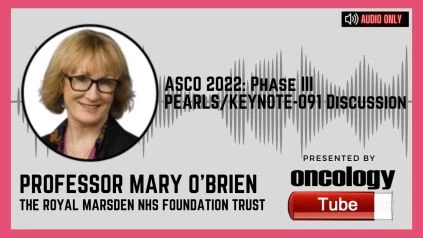Professor Mary O’Brien, Consultant Medical Oncologist MD FRCP at The Royal Marsden NHS Foundation Trust (RHM), Professor of practice (medical oncology) from Imperial College London. In this video, she speaks about the ASCO 2022 – Discussion – EORTC-1416-LCG/ETOP 8-15 – PEARLS/KEYNOTE-091 study of pembrolizumab versus placebo for completely resected early-stage non-small cell lung cancer (NSCLC): Outcomes in subgroups related to surgery, disease burden, and adjuvant chemotherapy use.
Origins:
Pembrolizumab significantly improved DFS compared to placebo in patients (pts) with completely resected stage IB (T 4 cm) to IIIA NSCLC per AJCC v7, regardless of PD-L1 expression (N = 1177, HR 0.76, 95 percent CI 0.63-0.91, P = 0.0014) in the second interim analysis (IA2) of the triple-blind, phase 3 PEARLS/KEYNOTE-091 study DFS is presented in subgroups based on surgery, disease load, and use of adjuvant chemotherapy.
Methodology:
Patients had pathologically proven, totally resected stage IB (T 4 cm) to IIIA NSCLC with no PD-L1 expression and an ECOG PS 0-1. Systematic full or lobe-specific mediastinal lymph node dissection was advised; at the very least, the subcarinal and one lobe-specific lymph node should have been explored. Adjuvant chemotherapy for four rounds was administered in accordance with local recommendations. Eligible patients were randomly assigned to receive pembrolizumab 200 mg or placebo Q3W for 18 doses (1 year). Treatment effects on DFS were evaluated in predefined subgroups of with and without adjuvant chemotherapy, as well as in exploratory subgroups defined by surgery type, pN stage, tumor size, number of adjuvant chemotherapy cycles, and adjuvant regimen; only subgroups of > 50 patients were studied. The IA2 data cutoff date was September 20, 2021. (median time from randomization to cutoff, 35.6 mo).
Outcomes:
The HR (95 percent CI) for DFS after lobectomy (n = 925) was 0.78 (0.64-0.96), bilobectomy (n = 92) was 0.85 (0.43-1.69), and pneumonectomy (n = 127) was 0.71 (0.40-1.24). HR (95 percent CI) for DFS in nodal status subgroups was 0.63 (0.46-0.86) for pN0 (n = 490), 0.77 (0.57-1.03) for pN1 (n = 456), and 1.00 (0.71-1.41) for pN2 (n = 231). The HR (95 percent CI) for DFS was 0.91 (0.69-1.20) for size 4 cm (n = 491) and 0.70 (0.55-0.89) for size > 4 cm (n = 685), regardless of nodal status. The HR (95 percent CI) for DFS in patients who had adjuvant chemotherapy (n = 1010) was 0.73 (0.60-0.89) and 1.25 (0.76-2.05) in those who did not (n = 167). The HR (95 percent CI) for DFS among patients who had adjuvant chemotherapy was 0.59 (0.28-1.26) for 1-2 (n = 67) and 0.74 (0.61-0.91) for 3-4 (n = 943); by regimen, it was 0.74 (0.55-0.98) for cisplatin + vinorelbine (n = 491), 0.51 (0.31-0.83) for carboplatin + paclitaxel (n = 135), 1.21
Observations:
Pembrolizumab enhanced DFS versus placebo in patients with totally resected stage IB (T 4 cm) to IIIA NSCLC, regardless of surgical type, lymph node involvement, tumor size, or type and extent of adjuvant treatment. These findings support the use of pembrolizumab as adjuvant therapy after total resection and, if required, adjuvant chemotherapy for early-stage NSCLC. NCT02504372 is the clinical trial number.

